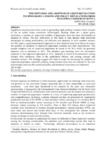| dc.description.abstract | Significant advances have been made in generating high yielding varieties which are part
of the so called Green revolution technologies. Raising hopes for a pulse green
revolution, a number of improved varieties of pigeonpea have also been developed and
released in Africa. The key motivation of this study is that, despite their perceived
advantages in raising productivity, the diffusion and adoption of such varieties remains
low We apply a quasi-experimental approach to data obtained from rural Kenya to assess
the patterns of adoption of improved pigeonpea varieties and their determinants. The
sample adoption rate of improved pigeonpea is found to be 36% while the potential
adoption rate is estimated at 48%. The adoption gap resulting from the incomplete
exposure to the improved pigeonpea is 12%. Adoption is found to be prominent among
farmers with residences close to the agricultural offices, and among younger and
wealthier farmers. The findings suggest that there is scope for increasing the adoption of
improved pigeonpea, especially among young farmers once they are exposed to the new
technologies and once the associated policy and technical constraints are addressed.
JEL Codes: | en_US |

